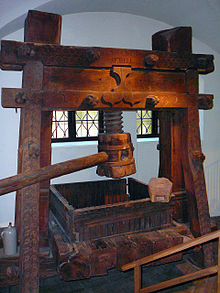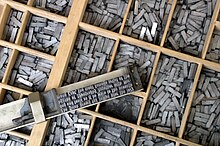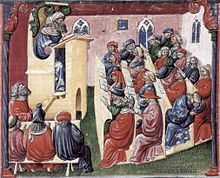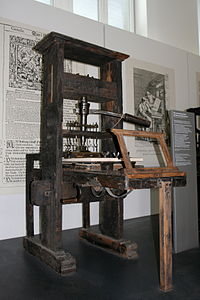Marinoni's Rotary Printing Press
The greatest progress that has been made in recent years in the art of printing is in the invention of the high speed press provided with continuous paper.
Three French constructors, Messrs. Marinoni, Alauzet, and Derriey, have brought this kind of apparatus to such a degree of perfection that the majority of foreign journals having a large circulation buy their presses in France. We reproduce in Fig. 1 a perspective view of the Marinoni press, and in Fig. 2 a diagram showing the parts of the same. In order to give a complete description of it, we cannot do better than to reproduce the very interesting study that has been made of it by Mr. Monet, a civil engineer.

FIG. 1.--MARINONI'S ROTARY PRINTING PRESS.
The roller, J (Fig. 2), is placed in the machine in the state in which it is received from the paper manufactory. The paper unwinds, runs over the rollers, e and e', which serve only for tautening it, and then passes between the two cylinders, A and B. The cylinder, A, carries the form, and B carries the blanket, and the paper thus receives its first impression. It afterward passes between the cylinders, A' and B', and receives an impression on the other side, the cylinder, A', carrying the form, and B' the blanket. Being now printed on both sides, it passes between the cylinders, KK', which cut it off and allow the sheet to slide between the cords of the rollers. These latter lead the sheets over the rollers, g h, on which they wind, one over the other, when the rollers, a a', are in the position shown by unbroken lines in the cut.
The part of the machine that holds the rollers, g h, and the different cords that wind over them, is the accumulator, and it is in this part of the press that the sheets accumulate, one over the other, to any number desired.
The size of the rollers, g h, and their distance apart are so regulated that when the sheet reaches the accumulator, it falls exactly on those that have preceded it. When the proper number of sheets is in the accumulator (4 or 5 being the number most employed for afterward facilitating the separation into packets on the receiving table), the two small rollers, a a', advance over the rack, N, and the sheets, instead of continuing to roll over into the accumulator, fall on the rack and are deposited by it upon the receiving table, O.

FIG. 2.--MARINONI'S PRESS.
The rack having fallen twenty times, and deposited five sheets each time, or one hundred in all, the table moves in such a way as to prevent the sheets subsequently deposited from getting mixed with them. When the rack has fallen twenty times, the table returns to its initial position.
The distributing rollers, D, come in contact with the inking rollers, I, once during each revolution of the printing cylinders, and are mounted on racking levers provided with regulating screws that permit of easily regulating the amount of ink taken up. The supports of the inking rollers are movable and can be made to approach or recede from the distributing rollers, so as to still further vary the amount of ink taken up by them.
The distributing rollers supply the ink to a roller, E, of large diameter, which, having a backward and forward motion, begins to distribute the ink and to transmit it to a second roller, F, of the same diameter. This latter then spreads it over a metallic cylinder, G, which is of the same diameter as the printing cylinders, and against which revolve three distributing rollers, H, that have a backward and forward motion.
Between the cylindrical inking table, G, and the type cylinder, there are situated inking cylinders, T, of large diameter, that constantly take up ink from the inking table and distribute it over the types.
The machine here described, when designed for printing large sized journals, has cylinders whose circumference corresponds to the size of paper for two widths of pages, and whose length is sufficient to allow it to receive two forms. Each cylinder, then, carries four forms, or eight in all, and prints two complete copies at each revolution.
The large sheet cut off by the cylinders, K K', contains, then, two copies; and this sheet, on passing under the roller, f is again cut in two by a disk which separates it in a direction perpendicular to the cylinders.
To this press there may be added a mechanical folder of Mr. Marinoni's invention, capable of folding a journal five times.--Annales Industrielles.
Three French constructors, Messrs. Marinoni, Alauzet, and Derriey, have brought this kind of apparatus to such a degree of perfection that the majority of foreign journals having a large circulation buy their presses in France. We reproduce in Fig. 1 a perspective view of the Marinoni press, and in Fig. 2 a diagram showing the parts of the same. In order to give a complete description of it, we cannot do better than to reproduce the very interesting study that has been made of it by Mr. Monet, a civil engineer.

FIG. 1.--MARINONI'S ROTARY PRINTING PRESS.
The roller, J (Fig. 2), is placed in the machine in the state in which it is received from the paper manufactory. The paper unwinds, runs over the rollers, e and e', which serve only for tautening it, and then passes between the two cylinders, A and B. The cylinder, A, carries the form, and B carries the blanket, and the paper thus receives its first impression. It afterward passes between the cylinders, A' and B', and receives an impression on the other side, the cylinder, A', carrying the form, and B' the blanket. Being now printed on both sides, it passes between the cylinders, KK', which cut it off and allow the sheet to slide between the cords of the rollers. These latter lead the sheets over the rollers, g h, on which they wind, one over the other, when the rollers, a a', are in the position shown by unbroken lines in the cut.
The part of the machine that holds the rollers, g h, and the different cords that wind over them, is the accumulator, and it is in this part of the press that the sheets accumulate, one over the other, to any number desired.
The size of the rollers, g h, and their distance apart are so regulated that when the sheet reaches the accumulator, it falls exactly on those that have preceded it. When the proper number of sheets is in the accumulator (4 or 5 being the number most employed for afterward facilitating the separation into packets on the receiving table), the two small rollers, a a', advance over the rack, N, and the sheets, instead of continuing to roll over into the accumulator, fall on the rack and are deposited by it upon the receiving table, O.

FIG. 2.--MARINONI'S PRESS.
The rack having fallen twenty times, and deposited five sheets each time, or one hundred in all, the table moves in such a way as to prevent the sheets subsequently deposited from getting mixed with them. When the rack has fallen twenty times, the table returns to its initial position.
The distributing rollers, D, come in contact with the inking rollers, I, once during each revolution of the printing cylinders, and are mounted on racking levers provided with regulating screws that permit of easily regulating the amount of ink taken up. The supports of the inking rollers are movable and can be made to approach or recede from the distributing rollers, so as to still further vary the amount of ink taken up by them.
The distributing rollers supply the ink to a roller, E, of large diameter, which, having a backward and forward motion, begins to distribute the ink and to transmit it to a second roller, F, of the same diameter. This latter then spreads it over a metallic cylinder, G, which is of the same diameter as the printing cylinders, and against which revolve three distributing rollers, H, that have a backward and forward motion.
Between the cylindrical inking table, G, and the type cylinder, there are situated inking cylinders, T, of large diameter, that constantly take up ink from the inking table and distribute it over the types.
The machine here described, when designed for printing large sized journals, has cylinders whose circumference corresponds to the size of paper for two widths of pages, and whose length is sufficient to allow it to receive two forms. Each cylinder, then, carries four forms, or eight in all, and prints two complete copies at each revolution.
The large sheet cut off by the cylinders, K K', contains, then, two copies; and this sheet, on passing under the roller, f is again cut in two by a disk which separates it in a direction perpendicular to the cylinders.
To this press there may be added a mechanical folder of Mr. Marinoni's invention, capable of folding a journal five times.--Annales Industrielles.
 He who first shortened the labor of copyists by device of movable types was disbanding hired armies, and cashiering most kings and senates, and creating a whole new democratic world: he had invented the art of printing.
He who first shortened the labor of copyists by device of movable types was disbanding hired armies, and cashiering most kings and senates, and creating a whole new democratic world: he had invented the art of printing.







